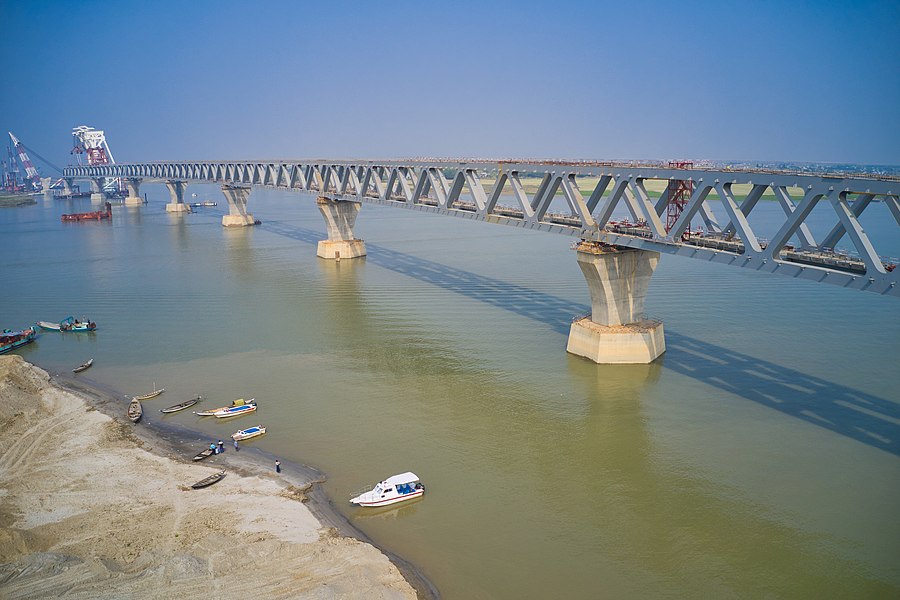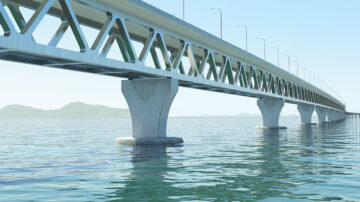The Padma Multipurpose Bridge is a multipurpose road-rail bridge across the Padma River, the main distributary of Ganges, under construction in Bangladesh with its own resources. It will connect Louhajong, Munshiganj to Shariatpur and Madaripur, linking the south-west of the country, to northern and eastern regions. Padma Multipurpose Bridge is the most challenging construction project in the history of Bangladesh. The two-level steel truss bridge will carry a four-lane highway on the upper level and a single track railway on a lower level. The bridge with 150.12 m (492.5 ft) long 41 spans, 6.150 km (3.821 mi) total length and 18.18 m (59.6 ft) width, is going to be the longest bridge in Bangladesh, the second longest in the Indo-Gangetic Plain after Bhupen Hazarika Setu in Assam and the longest over Ganges in terms of both span and the total length.[6] Padma Multipurpose Bridge, when commissioned, is expected to boost the GDP of Bangladesh by as much as 1.2 percent.

The detailed design of the Padma Multipurpose Bridge is being delivered by a team of international and national consultants headed by AECOM. The team comprises AECOM, SMEC International, Northwest Hydraulic Consultants and ACE Consultants, with additional assistance from Aas-Jakobsen and HR Wallingford. The Project comprises two phases. Phase 1 of the Project includes the Design Phase leading through procurement action to the award of construction contracts. Phase 2 is the Construction Phase. Phase 1 of the project commenced on 29 January 2009. A dedicated Project Office was set up in Dhaka in March 2009. Detailed design of the main bridge was carried out in AECOM’s Hong Kong office. All work carried out by the design team was carried out within the framework of AECOM’s Quality Management System (QMS) which is independently accredited to AS/NZS ISO 9001. The QMS is designed to control all project work undertaken by the team. A project-specific Design Management Plan was established at the outset of the project, In March 2009, the Government of Bangladesh requested AECOM to accelerate the design with a view to ensuring construction could be completed before the end of 2013. This necessitated the mobilization of additional personnel within the design team. Bangladesh Bridge Authority (BBA) established an internationally recognized Panel of Experts comprising five national and five international experts to review the design at regular intervals. In addition, an Independent Checking Engineer, Flint & Neill, was engaged to review the design criteria, specification and drawings produced by the design team to ensure the design meets the project requirements and to undertake an independent check of the detailed design of the main bridge and river training works. A key feature of the detailed design was the integration of Bangladesh counterparts into the design team, which allowed the successful training of a significant number of Bangladesh personnel in all aspects of the project and the subsequent transfer of the high level of technology involved in this large and complex project.
World Records: The bridge with 150.12 m (492.5 ft) long 41 spans, 6.150 km (3.821 mi) total length and 18.18 m (59.6 ft) width, is going to be the Longest bridge in Bangladesh, the Second Longest in the Indo-Gangetic Plain after Bhupen Hazarika Setu in Assam and the longest over Ganges in terms of both span and the total length. Along with these records three remarkable world records listed to the Bridge as follows-
First One is the piling of the Padma bridge. Concerned engineers say that steel piles have been placed at a maximum depth of 122 meters under the pillars of the Padma Bridge. These piles have a radius of three meters. No bridge in the world has ever been pilled so deep and thick piles have not been laid.
The second record is that ‘Friction Pendulum Bearings’ have been installed to vaccinate the Padma Bridge from earthquakes. The bearing capacity is 10 thousand tons. So far no bridge in the world has been fitted with bearings of such capacity. The Padma Bridge will be able to withstand 9 magnitude earthquakes on the Richter scale.
And the third record is river governance. A 1.10 billion contract has been signed with Chinese contractor Sinohydro Corporation for river management. Never before in the world has there been such a big tender for river governance alone. Besides, very fine (microfine) cement has been used in piling and some parts of poles in Padma bridge. These cements were imported from Australia. Such ultra-fine cement is not commonly used.


Leave a Reply
You must be logged in to post a comment.